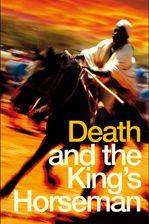Anyone who went to the Jorvik Viking Centre in York in the 80s, perhaps on a school trip or family outing, will remember two things about it: firstly the narration by Magnus Magnusson and secondly the smell experience. Magnus Magnusson sadly died in 2007 but the power of scent and sound to stimulate the imagination lives on in Death and the King’s Horseman by Wole Soyinka in the Olivier at the National Theatre. Burning incense mingles with talking drums, live music and seeds scattering across the stage to take the audience to the market in the Yoruba town of Oyo in Nigeria in the 1940s.
Soyinka’s play tells the story of the final day in the life of Elesin, the King’s Horseman, who must follow his deceased master into the next world. Elesin has enjoyed a privileged life and is keen to get the most out of his last 24 hours which he spends being honoured by his people and taking a young wife in every sense of the word. Elesin is prevented from fulfilling his destiny, with tragic consequences, by the unsolicited intervention of Mr Simon Pilkings, the British colonial officer for the area.
The play is about much more than a single paragraph plot outline can convey. The way in which the story unfolds is as important as the events it chronicles – events which actually took place in 1946. Director Rufus Norris spent considerable time rehearsing in Oyo and he and choreographer Javier DeFrutos make full use of Yoruba traditions of storytelling: dance, chanting, masquerade and ensemble work meld with the authentic props and bundles of clothes strung high above Katrina Lindsay’s simple set and picked out by Paule Constable’s expert lighting. The overall effect is both foreign and familiar” unsettling and comforting by turns.
Such is Soyinka’s skill as a dramatist that some will see Elesin as a tragic hero, many will be exercised by the political significance of actors whiting up to play Pilkings and his cronies and others will find themselves engaged in a dialogue about post-colonialism.
I saw a story of male vanity exposed in all its blustering, destructive folly in worlds in which true wisdom dwells in the domain of women. The play’s funniest moments come when the market women lampoon the hapless, inept policemen and the colonial establishment. The police are powerless against the derision of their mothers and sisters” their weapons and uniforms turned from badges of office to boys’ toys. Jenny Jules puts in a poised performance as Jane Pilkings attempting to mediate between her impetuous, pompous husband and Olunde, Elesin’s son, played with quiet dignity by Kobna Holdbrook-Smith. Claire Benedict excels as Iyaloja, ‘Mother’ of the market, who does her best to check Elesin’s last wayward desires only to have to bring him his dead son in the end. Benedict’s voice and stage presence effortlessly swell to fill the Olivier Theatre in the final scenes.
Death and the King’s Horseman is at the National Theatre until 17 June 2009





